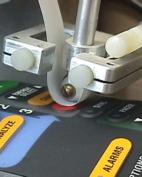
The actual finish of a silicone mold greatly determines what the final part will look like and how it will function. Finishes can range from a smooth, highly polished uniform finish that is completely free of tool marks to a “Commercial” finish which consists of good machine shop practices and generally requires no polishing. A highly polished “mirror” finish when used with silicone rubber, can give the rubber a glass like quality. This is mainly used for window features within silicone keypads and components. A highly polished finish will also give the silicone more of a “tacky” feel. The less tack, and the less clarity.
Flash is another factor that can play into the finish and appearance of your silicone rubber product. Flash is defined as excess rubber on a molded product. Flash is generally caused by an overflow of a cavity within the mold. The method in which the flash is removed can give differences in appearance of the final product. There are a few methods of flash removal including: Buffing, Die Trim, Hand Trim, and Tumble Trim. Determining how much flash you would allow on your silicone product typically determines the method in which would be used to remove it.
Buffing is typically done with the use of a Dremel and is a quick method for removing large amounts of flash, typically around the parting line of an undercut.
Die Trimming is done with the use of a cutting tool that is shaped to the final product. This is typically used when the flash is holding multiple cavities together in a “mat”.
Hand trimming is typically done with the use of cutting pliers and other hand tools.
Tumble trimming is done with the use of a rotating barrel the parts are placed in. The parts are typically frozen using liquid nitrogen which makes the flash more brittle, so that it easily breaks off.
A guideline for tolerances of flash is listed below:
- 0.003” of Flash: This tolerance would typically require buffing
- 0.016” of Flash: This tolerance would typically require buffing, precision die trimming, or precision hand trimming.
- 0.032” of Flash: This tolerance would typically call for die trimming, tumbling, or hand trimming.
Another factor is whether or not mold release was used during the molding process of your silicone rubber component. Typically molding release is not required when molding silicone rubber. Unfortunately there are some cases where it may need to be used, and the use of mold release can give an oily appearance. Mold release can affect the adhesion when used on inserts that are to be over-molded, or can affect the decoration stage if a keypad is to have printing done. It is important to designate whether mold release can be used on the components print.
At SiTECH we have a vast knowledge and experience dealing with the liquid silicone rubber and specific finishes for tooling. If you have any questions or would like to discuss your silicone rubber needs please call us at 757-887-8488 or simply submit a quote online here.






